I wrote a small article for Duckworks Magazine about the Classic & Wooden Boat Festival in Sydney in 2008, and at the end of which I urged attendance at the biggest such festival in Australia, the biannual Australian Wooden Boat Festival in Hobart, Tasmania, February 2009, what could I do but actually go to the Festival myself.
| From the barque Otago which was commanded by Joseph Conrad! He raved about the qualities of the Otago and it ended its days as a coal hulk in Hobart This isn't the Festival but across the road in the Tasmanian Maritime Museum! |
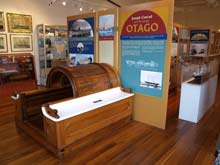 |
So off I went for the weekend on Friday evening 6th February 2009 to spend Saturday & Sunday at the Festival. Saturday dawned rainy and cool. Ironically, just a couple of hundred kilometres to the north across Bass Strait in Victoria, devastating bushfires were raging with searing 40+ degree Cel. temperatures. Subsequently, and very sadly, that tragedy has overshadowed this year’s Festival.
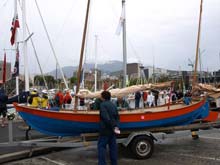 |
Mt Wellington shrouded in mist and rain on the same day as the fires across Bass Strait in Victoria |
This was the first Hobart Festival that I had attended and its sheer size was almost overwhelming. First stop at the Elizabeth Street Pier was the Lady Nelson, the Tasmanian sail training vessel which was built as a bicentennial project in 1987-88 to re-create the 18th C brig of the same name. The original Lady Nelson was used in the first European settlement of Tasmania at Risdon Cove on the eastern shore of the Derwent River, and only a few kilometres away from the present city of Hobart. (See the Lady Nelson Web Site for more information about the replica and the original: https://www.ladynelson.org.au/corframe.htm)
| This is the replica brig Lady Nelson which is a Tasmanian sail training brig built for the Bicentennial in 1987-88 It is a replica of the brig which was used to make the first European settlement in Tasmania (then called Van Dieman's Land) in 1803. The original had quite a significant career in the European settlement of both New South Wales, Van Dieman's Land and Victoria. It was eventually lost in what is now Indonesia. |
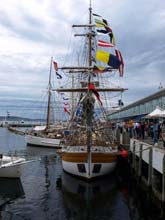 |
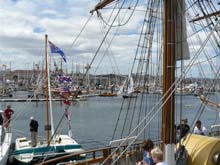 |
Tasmanian Tall Ship Lady Nelson in the foreground |
In the Pavilion, a large number of ship models were on display, including a very impressive large model of the Carnegie Institution’s non-magnetic research vessel, Carnegie. After the Model Pavilion, I came across the May Queen floating in Constitution Dock. This boat was built as a trading ketch in Tasmania in 1867 and continued working in southern Tasmania until 1957. Since then the May Queen has been restored and is currently owned by the Tasmanian Maritime Museum with its headquarters just over the road from Constitution Dock, on the corner of Davey & Argyle Streets in the Carnegie Building. The May Queen’s “back” was broken some years ago, so a steel shoe was fitted along the bottom of the keel which has meant that her centreboard can no longer be deployed, thus ending her sailing days.
| The May Queen was built in Tasmania in 1867 and traded on the south coast until 1957 Its back is broken and they don't sail it now but it's still afloat! |
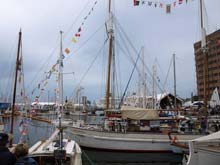 |
Constitution Dock was the scene for rowing lessons in all sorts of water craft and many younger visitors to the Festival were able to paddle around under the watchful eye of Festival staff, dodging radio-controlled model yachts and fellow rowers.
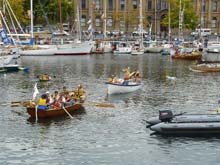 |
Rowing lessons in Constitution Dock, the trading ketch May Queen (1867) in the background |
There were lots of small boats on the docks around the pond areas of Constitution Dock and the adjacent Victoria Dock, a highlight for me being the well preserved Huon Pine clinker dinghies, including the dinghy built as the tender for the MV Egeria, formerly, the Governor of Tasmania’s official launch. The Egeria was in attendance at the Festival, too, as an official vessel, and what a fine boat she is. Built of Huon Pine, by Purdon & Featherstone, Napoleon Street, Hobart, for the Marine Board of Hobart, Egeria was launched in October 1941.
| This is a tender built in 1941 by the Battery Point boat builder Reg Fazackerty for use as a tender to the Governor's launch MV Egeria - This boat is typical of the fine clinker dinghies built by Fazackerty in the famed Tasmanian timber Huon Pine |
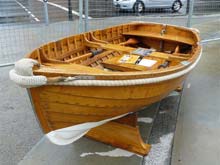 |
Huon Pine grows at something like 3 mm a year and is one of the most durable timbers known. So the timber in these boats is literally many thousands of years old. No wonder it’s taking on a mystical quality and people touch it in an almost reverential way.
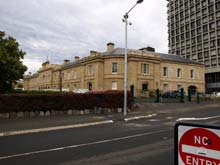 |
Parliament House Hobart 1935-1840 |
The one disappointment for me was the almost complete lack of Bolger boats. All I could see was one lone Micro Trawler, tucked away near a floating seafood diner in Constitution Dock. I did not see any Bolger sailing boats. Nor, for that matter, did I spot any Michalak designs or Welsford boats. But then, being more conventionally “good looking”, Welsford craft would not have stood out so much!
| The only Bolger boat that I could see at the Festival - a Micro Trawler |
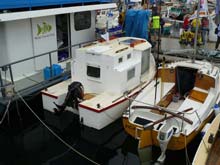 |
Sail training ships were in abundance: The biggest of these was the Sydney Heritage Fleet’s James Craig, which sailed down from New South Wales with a crew of paying passengers. I was just able to catch a photo of a double kayak under her bow, but missed the figurehead and ship’s name in the frame.
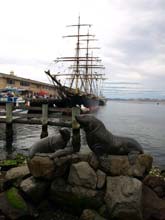 |
The James Craig was sailed down from Sydney for the event, it took paying "passenger" crew too! |
| This kayak looked like it was canvas to me and I took it as they paddled in under the bows of the James Craig, pity I missed the name & figurehead in the photo! |
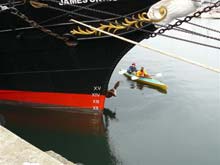 |
Morris Dancers did their thing beside the James Craig and there were folk groups and other entertainers performing all day long. They kept the throngs of visitors entertained when they needed a break from the boats.
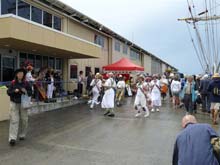 |
Morris Dancers on the pier beside the James Craig - they danced all day! |
Speaking of “breaks from boats”, I never thought that I would need such a thing, but the sheer size of this Festival had me eventually seeking refuge from such a nautical onslaught! Where else to do that but over in Salamanca Place at the Salamanca Markets where I quickly spotted chunks of Huon Pine for sale for very reasonable prices; I imagined talking to the airline cabin crew about where I could stow it on the plane, but sanity prevailed.
| Small boats in Constitution Dock |
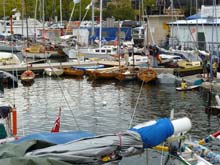 |
The Huon Pine for sale these days is not harvested from living trees but rather is reclaimed timber from logs dug out of river and creek beds. The fantastic preservation in such logs can be quite remarkable, with estimations varying about the length of time that they have been in the rivers from many decades to centuries.
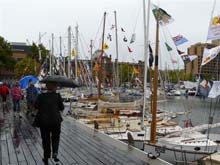 |
Constitution Dock view nice catboat in this picture |
A final walk on Sunday around the outer reaches of the Festival showed up some real gems, such as a replica of Joshua Slocum’s famous gaff yawl, Spray, and a very nice example it was too, built of Hoop Pine in 1987 by Phil Tucket & Norm Wright. No, not Huon Pine, but another fine timber just the same, and one grown in plantations these days.
| A very nice Spray replica called Jushua T built in Tasmania of Hoop Pine in 1987 |
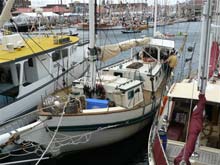 |
Another favourite of mine, at least, are the Wharram catamarans and on the same pier there was a 46ft Oro class Wharram built by Chris Dyer in Tasmania. Chris read quietly on the deck under an awning accompanied by his two trusty dogs, as the light drizzly rain washed his decks.
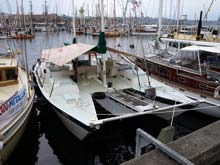 |
This is a Wharram Oro 46ft cat built in Tasmania by Chris Dyer a few years back, he had two dogs on board who looked very happy! |
The only other Wharram at this year’s Festival was a very nicely finished Tiki 21 called Double Dutch Two, which looked more like a Tiki 26 with its built-up cabins, very smartly turned out. It was a credit to its builder, Bart Witte.
| A Wharram Tiki 21 motors around Sullivan's Cove with a Japenese cruise ship and the Anzac Frigate Stuart in the background |
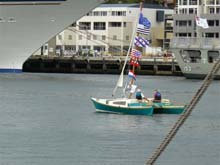 |
I did spot two Norwalk Island Sharpies sailing out on the Derwent Estuary on Sunday. The tan sail and green hulled boat, from that distance, looking suspiciously like Robert Ayliffe’s original Charlie Fisher which he’d sailed over from Victoria via the Bass Strait Islands for the last Festival. I wondered if he’d done the same again, this time! But it turned out to be a 26 footer, I later discovered.
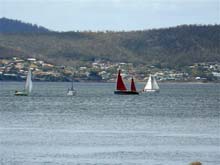 |
A Norwalk Islands Sharpie sailing on the Derwent. The far shore is still recovering from a bush fire a couple of years ago. |
| A bit of showing off here I think! |
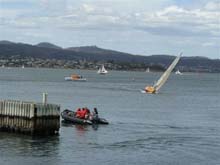 |
There was also a contingent of replica original 18ft Skiffs from the Sydney Flying Squadron, with Britannia leading the pack. Just look at the number of crew on this boat and they sailed right into the dock area, pulling up smartly just in time. Mainlanders showing off, no doubt!
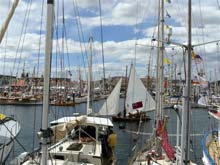 |
The replica 18ft Skiff Britannia sails in with a big crew! |
| A couple of 18ft skiffs sail in, this is looking north |
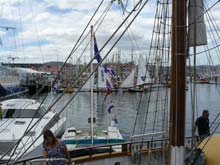 |
Later reading the Festival Programme and web pages, I realized that there were other boats and exhibits that I’d missed, but with a Festival on such a scale, you’d probably need all four days to really do it justice.
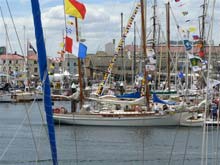 |
A wonderful Herreshoff Bounty shown here |
Then again, “Where you’d get the energy, I wouldn’t be knowing?”, as Mrs Doyle would say. And speaking of Craggy Isle, Tasmania may be craggy in a geological sense, but the warmth and friendliness at the Australian Wooden Boat Festival, Hobart, Tasmania, 2009, sure wasn’t craggy. A friendlier city than Hobart does not exist on this planet; a city full of history, natural beauty and charm. To be sure, to be sure!
More random pictures:
| Four men 4000 miles retracing the Bounty launch trip (see next pic) |
 |
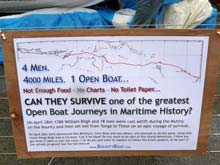 |
The Bounty expedition again |
| The stern of the Young Endeavour This is a youth sail training ship operated by the Royal Australian Navy and was a Bicentennial Gift from the People of the UK to Australia |
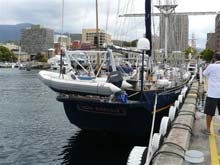 |
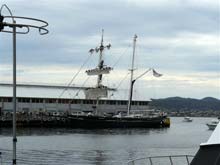 |
The is the Young Endeavour again with the youth trainee crew unfurling the sails |
| A great steam launch with lots of brass! |
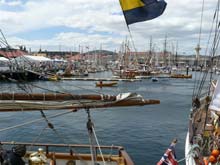 |
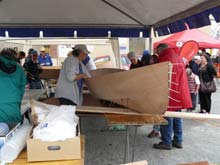 |
A local epoxy company had quite a few stitch & glue boats being built by Festival vistors |
*****
|

